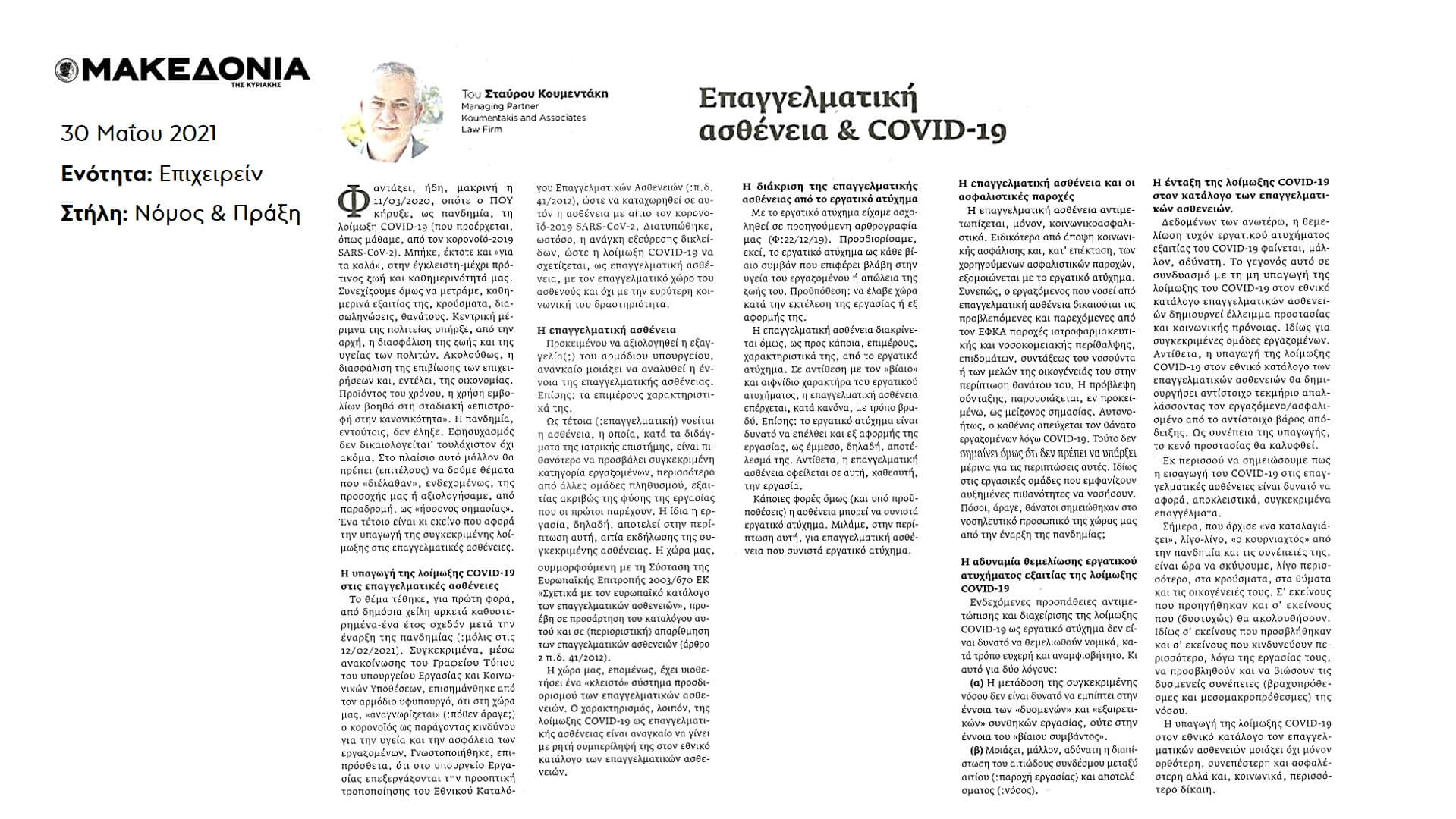11.3.2020 already seems distant. This was when the WHO declared the Covid-19 infection a pandemic (which, as we have learned, is a result of the Coronovirus-2019 SARS-CoV-2). It has, since then, “for good”, entered our quarantined, until recently, lives. But we continue to count, on a daily basis-because of it, cases, intubations, deaths. The main concern of the state has been, from the beginning, to ensure the life and health of the citizens. After that, to ensure the survival of businesses and, ultimately, the economy. In time, the use of vaccines helps to gradually “return to normalcy”. The pandemic, however, is not over. Complacency is not justified – at least not yet. In this context, we should probably (finally) look into issues that have possibly “missed” or we have inadvertently assessed them as “minor”. One such is the one that concerns the subordination of the specific infection to the occupational diseases.
Inclusion of Covid-19 infection in occupational diseases
The issue was raised, for the first time, by official sources quite late – almost a year after the start of the pandemic (: only on 12.02.2021). Specifically, through an announcement of the Press Office of the Ministry of Labor and Social Affairs, it was pointed out by the competent Deputy Minister, that in our country, the coronavirus is “recognized” (: how?) as a risk factor for the health and safety of employees. It was additionally announced that the Ministry of Labor is working on the prospect of amending the National Catalog of Occupational Diseases (: pd. 41/2012), in order to register the disease caused by Coronavirus-2019 SARS-CoV-2. There was, however, a need to find ways so that Covid-19 infection could be associated, as an occupational disease, with the patient’s workplace and not with his or her wider social activity.
Occupational disease
In order to evaluate the announcement (?) of the competent Ministry, it seems necessary to analyze the concept of occupational disease. Also: its individual characteristics.
Such (: occupational) means the disease, which, according to the teachings of medical science, is more likely to affect a certain category of employees, more than other groups of the population, precisely because of the nature of the work that the former provide. Work itself, that is, in this case, is the cause of the manifestation of the specific disease.
In our national law and, in particular, in social security law, the concept of occupational disease “has” a more specific definition. Our country, in compliance with the Recommendation of the European Commission 2003/670 EC “On the European list of occupational diseases”, annexed this list and (restrictive) listing of occupational diseases (article 2 p.d. 41 / 2012).
Our country, therefore, has adopted a “closed” system of identification of occupational diseases. As a consequence of their “numerus clausus”, the designation of Covid-19 infection as an occupational disease needs to be explicitly included in the national list of occupational diseases.
Occupational diseases, as listed in the national list, fall into five broad categories. These are, in particular, the:
(a) Diseases caused by chemical agents.
(b) Skin diseases caused by substances and agents not listed elsewhere.
(c) Diseases caused by inhalation of substances and agents not recorded elsewhere.
(d) Infectious and parasitic diseases.
(e) Diseases caused by those listed in presidential decrees physical factors.
From the above distinction, it being included in the category in the category of infectious and parasitic diseases of occupational diseases seems possible.
The distinction of occupational disease from occupational accident (accident at work)
We had dealt with the accident at work in a previous article. There, we identified the accident at work as any violent incident that causes damage to the employee’s health or loss of life. Prerequisite: for it to have taken place during the execution of the work or on its occasion. That is, there is a “causal link” between the work and the accident (: cause-and-effect relationship). Exception from the above: the case where the victim fraudulently caused the accident (art. 1 law 551/1915).
The occupational disease, however, is distinguished, in some of its individual characteristics, from an occupational accident. In contrast to the “violent” and sudden nature of the accident at work, occupational disease usually occurs slowly. Also: the accident at work can occur as a result of the work, as an indirect. On the other hand, occupational disease is due to the work itself.
Sometimes, however, the disease can be an accident at work. A disease that is an accident at work is one that is dormant and is manifested (or aggravated) by “abnormal” working conditions, which are of a violent nature. We are talking, in this case, about an occupational disease that constitutes an occupational accident.
A similar case is the one in which an employee provides their services under normal and agreed upon conditions but is ill. If they inform their employer about their illness, the latter (employer) must employ the (sick) employee in a different job-suitable for their state of health. If, in any case, they continue to provide their work under the same conditions (under which the illness occurred), any deterioration will be deemed to constitute an accident at work.
Occupational disease and insurance benefits
Occupational disease is treated only the level of social security benefits. In particular, from the point of view of social security and, consequently, of the insurance benefits granted, it is equated with the accident at work (articles 8 §4 & 34 §1 Law 1846/1951). Therefore, the employee who suffers from an occupational disease is entitled to the benefits provided by E.F.K.A. of medical and hospital care, of allowances, pension of the patient or their family members in case of their death. The provision of pension is presented, in this case, as of major importance. Of course, everyone avoids the death of employees due to Covid-19. This does not mean, however, that these cases should not be taken care of. Especially in working groups that show an increased chance of getting sick. How many deaths have occurred in the nursing staff of our country since the beginning of the pandemic?
The inability to prove an accident at work due to the Covid-19 infection
Efforts to treat and manage Covid-19 infection as an occupational accident cannot be easily and legally substantiated. This is for two reasons:
(a) The transmission of this disease may not fall within the meaning of “adverse” and “exceptional” working conditions, nor within the meaning of a “violent incident”. It is, moreover, known that its transmission takes place under completely normal working conditions (although, in some cases, the probability of transmission is known to be, due to the nature of the work, significantly increased).
(b) It seems rather impossible to determine the causal link between cause (: provision of work) and result (: disease). Outbreaks appear to be exacerbated within, but also outside the workplace. It is not possible, therefore, to determine with certainty whether an employee contracted the disease in the course of providing their work or not.
The inclusion of the Covid-19 infection in the list of occupational diseases
Given the above, establishing an accident at work due to Covid-19 seems rather impossible. This, combined with the non-inclusion of Covid-19 infection in the national list of occupational diseases, creates a deficit of protection and social welfare. Especially for specific groups of employees. On the other hand, the inclusion of Covid-19 infection in the national list of occupational diseases will create a corresponding presumption, relieving the employee / insured person from the corresponding burden of proof. As a consequence of the inclusion, the protection gap will be filled.
Furthermore, it should be noted that the inclusion of Covid-19 in the list of occupational diseases may relate exclusively to specific occupations. Occupations, that is, which by their nature involve more chances of transmitting the disease among their employees. Corresponding restrictions are provided, moreover, by the existing institutional framework (: pd. 41/2012).
Today, when the effects and consequences of the pandemic are starting to, little by little, settle down, it is time to care, a little more, for the victims and their families. For those of the past and for those that are (unfortunately) to follow. Especially for those who are affected and those who are most at risk, due to their work, to be affected and experience the adverse consequences (short or long term) of the disease.
The inclusion of the Covid-19 infection in the national list of occupational diseases seems not only more correct, more consistent and safer but also, socially, more equitable.

Stavros Koumentakis
Managing Partner
P.S. A brief version of this article has been published in MAKEDONIA Newspaper (May 30, 2021).

Disclaimer: the information provided in this article is not (and is not intended to) constitute legal advice. Legal advice can only be offered by a competent attorney and after the latter takes into consideration all the relevant to your case data that you will provide them with. See here for more details.
